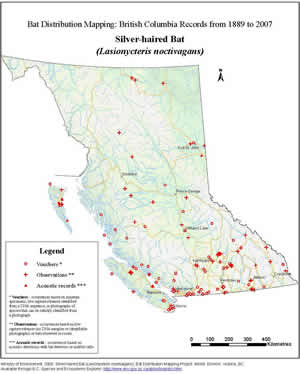View Desktop Page
Lasionycteris noctivagans (Le Conte)
Silver-Haired Bat
Family: Vespertilionidae
Silver-Haired Bat
Family: Vespertilionidae
Species account authors: David Nagorsen and Mark Brigham.
Extracted from the Bats of British Columbia
Extracted from the Bats of British Columbia
Introduction click to expand contents
|
Illustration click to expand contents
Click on the image(s) below to view an expanded illustration for this taxon.


Illustration Source: : Bats of British Columbia by David Nagorsen and Mark Brigham © Royal BC Museum
Species Information click to expand contents
The fur of the Silver-haired Bat is dark brown or black with scattered silver-white-tipped hairs giving it a lightly-frosted appearance. Old individuals tend to have fewer white-tipped hairs and their fur often appears pale brown or yellowish. On the underside, the frosted hairs are concentrated in the belly. The ear is short and round with a short, blunt tragus. The ears and wing membranes are black. The dorsal surface of the tail membrane is lightly furred. The calcar lacks a keel. The skull has a blunt rostrum and is flat in profile.
IdentificationThe only Canadian species this bat could be confused with is the Hoary Bat (Lasiurus cinereus), but the Silver-haired Bat is much smaller (forearm less than 44 mm). Also its light covering of fur at the base of the tail membrane contrasts with the thickly furred dorsal surface of the Hoary Bat's tail membrane. Among British Columbian bats, only Townsend's Big-eared Bat (Plecotus townsendii) has the same dental formula. The skull of the Silver-haired Bat can be readily distinguished from that of Townsend's Big-eared Bat by its flat profile.
Dental Formulaincisors: 2/3
canines: 1/1
premolars: 2/3
molars: 3/3
Measurementstotal length: 100 (90-117) n = 68
tail vertebrae: 41 (31-50) n = 70
hind foot: 9 (6-11) n = 69
ear: 12 (9-15) n = 17
tragus: 7 (4-8) n = 22
forearm: 41.4 (39.1-43.9) n = 56
wingspan: 291 (200-354) n = 38
weight: 9.0 (5.8-12.4) n = 14
Biology click to expand contents
|
Habitat click to expand contents
|
Distribution click to expand contents
|
Taxonomy click to expand contents
|
Remarks click to expand contents
|
Status Information click to expand contents
|
BC Ministry of Environment: BC Species and Ecosystems Explorer--the authoritative source for conservation information in British Columbia. |
